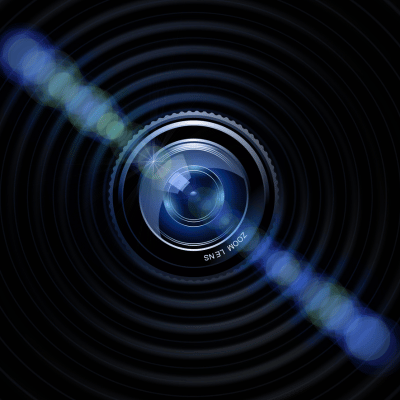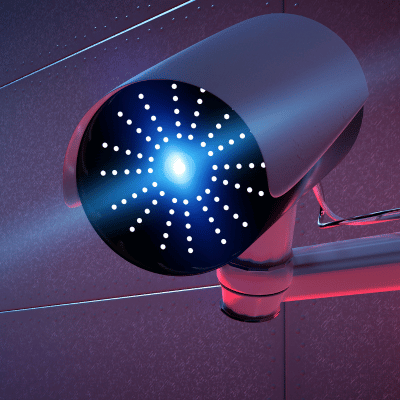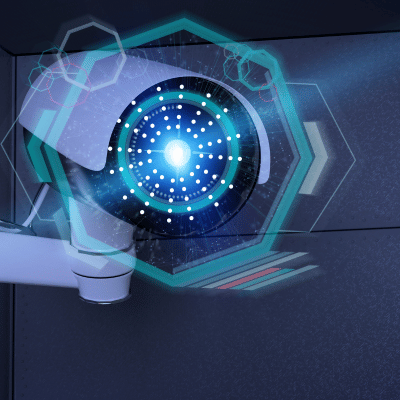When Were Security Cameras Invented?
 Security cameras have become an indispensable component of modern society, offering peace of mind to homeowners and businesses alike. These surveillance systems play a vital role in monitoring public spaces, securing private properties, and safeguarding sensitive areas. But how did security cameras evolve into the advanced devices we rely on today? This blog explores the invention of security cameras, tracing their development from rudimentary systems to the sophisticated surveillance technologies we use now.
Security cameras have become an indispensable component of modern society, offering peace of mind to homeowners and businesses alike. These surveillance systems play a vital role in monitoring public spaces, securing private properties, and safeguarding sensitive areas. But how did security cameras evolve into the advanced devices we rely on today? This blog explores the invention of security cameras, tracing their development from rudimentary systems to the sophisticated surveillance technologies we use now.
An Overview of the Evolution of Security Camera Technology
| Time Period | Technology/Development | Key Features |
| 1920s | Early Video Surveillance Systems | Large, cumbersome cameras; used in the government and film industry |
| 1940s-1950s | CCTV (Closed-Circuit Television) | Used in military and government; analog signals |
| 1970s-1980s | Digital Cameras | Higher image quality; digital storage |
| 1990s | IP Cameras | Remote access; network integration; higher resolution |
| 2000s-Present | Smart Cameras with AI Integration | Motion detection; facial recognition; smart home integration |
The Early Beginnings: Mechanical Surveillance Devices
Before the advent of video cameras, surveillance was managed through simpler means. Ancient civilizations utilized methods such as watchtowers and sentinels to monitor threats and maintain security. These early forms of surveillance laid the foundation for the development of more complex systems.
Peepholes, for example, allowed individuals to observe who was outside their doors without revealing themselves- a basic form of mechanical surveillance. These methods, while primitive, were essential in maintaining order and security in communities long before the invention of electronic systems.
The Invention of Security Cameras: A Step into the 20th Century
The First Recorded Use (1920s)
 The concept of using cameras for surveillance began to take shape in the early 20th century. One of the first known uses of video surveillance occurred in Stalin’s Russia during the 1920s. These early systems were rudimentary, consisting of large, cumbersome cameras connected to television sets. They were primarily used to monitor and secure sensitive government facilities, marking the beginning of what we now recognize as security camera technology.
The concept of using cameras for surveillance began to take shape in the early 20th century. One of the first known uses of video surveillance occurred in Stalin’s Russia during the 1920s. These early systems were rudimentary, consisting of large, cumbersome cameras connected to television sets. They were primarily used to monitor and secure sensitive government facilities, marking the beginning of what we now recognize as security camera technology.
Simultaneously, the motion picture industry began utilizing video surveillance to monitor film sets. This was done to ensure the safety of actors and crew members while capturing authentic scenes. Though these early cameras required significant manpower to operate, they represented a critical step forward in the development of surveillance technology.
Early Analog Cameras
Following the initial experiments in video surveillance, the development of analog security cameras began to shape the future of security systems. These early analog cameras captured images by converting light into electrical signals, which were then transmitted to a monitor or recorded onto tape. Despite their limitations, these cameras were groundbreaking, offering a new way to monitor and secure areas remotely.
The Impact of WWII
World War II significantly advanced surveillance technology. The need for secure communication and monitoring systems led to the development of Closed-Circuit Television (CCTV). For example, the Germans used CCTV to monitor rocket tests, ensuring their operations were conducted safely and securely. This wartime innovation laid the foundation for the widespread adoption of CCTV systems in the subsequent decades.
The Growth of Surveillance Technology: From Analog to Digital
The Introduction of CCTV Systems (1940s-1950s)
The post-war period saw the introduction of CCTV systems in public spaces and industries. Initially, these systems were used primarily by governments and large corporations to monitor sensitive areas. The technology was still relatively expensive and complex, limiting its use to high-security environments. However, as technology improved and costs decreased, CCTV systems became more accessible, paving the way for their widespread use.
The Advent of Digital Cameras (1970s-1980s)
The 1970s and 1980s marked a significant turning point in the history of security cameras with the advent of digital technology. Unlike analog cameras, which recorded footage on magnetic tapes, digital cameras stored images electronically. This innovation allowed for higher image quality, easier storage, and more efficient retrieval of footage. As a result, digital cameras quickly gained popularity, particularly in commercial and residential security.
The Rise of IP Cameras (1990s-2000s)
The introduction of Internet Protocol (IP) cameras in the 1990s revolutionized the field of surveillance. IP cameras offered numerous advantages over their analog counterparts, including remote access, high-resolution images, and the ability to integrate with other security systems. This era also saw the emergence of networked surveillance systems, where multiple cameras could be connected and monitored from a central location.
IP cameras have continued to evolve, incorporating features such as motion detection, night vision, and wireless connectivity. These advancements have made surveillance more effective and convenient, solidifying the role of security cameras as a staple of modern security systems.
The Proliferation of Security Cameras: Becoming a Global Standard
 Surveillance in Public Spaces (1990s-Present)
Surveillance in Public Spaces (1990s-Present)
The 1990s marked the beginning of widespread surveillance in public spaces. Governments and businesses around the world began installing cameras in city centers, airports, and other public areas to deter crime and enhance security. The growth of surveillance was rapid, with millions of cameras being installed globally. Today, it is estimated that there are over one billion surveillance cameras in use worldwide. Eleven of the world’s 20 most surveilled cities are located in China, which accounts for approximately 54% of all installed security cameras globally. The remaining top surveilled cities include New York, London, Seoul, Moscow, Delhi, Chennai, Singapore, Mumbai, and Mexico City.
Regulatory and Privacy Concerns
The proliferation of security cameras has not been without controversy. As surveillance became more common, concerns over privacy and civil liberties emerged. Various countries have implemented regulations to govern the use of surveillance cameras, balancing the need for security with the protection of individual privacy. For example, the General Data Protection Regulation (GDPR) in Europe sets strict guidelines for the use of video surveillance in public and private spaces.
Modern Security Cameras: Features and Technologies
Smart Home Integration
In recent years, security cameras have become an integral part of smart home systems. These cameras can be connected to other smart devices, allowing homeowners to monitor their properties remotely via smartphones or tablets. Features such as real-time alerts, two-way communication, and cloud storage have made smart cameras a popular choice for home security.
AI and Machine Learning in Surveillance
Artificial Intelligence (AI) and Machine Learning (ML) are transforming the capabilities of security cameras. Modern systems can now analyze footage in real-time, detecting unusual behavior, recognizing faces, and even predicting potential threats. These advancements are making surveillance more proactive and effective, reducing the reliance on human operators to monitor live feeds.
The Future of Security Cameras
The future of security cameras is likely to be shaped by continued advancements in AI and other technologies. We can expect to see even more sophisticated systems capable of autonomous decision-making, enhanced image quality, and improved integration with other security measures. The North American smart home security camera market was valued at $3.48 billion in 2023. In fact, Americans are caught on camera an average of 238 times every week. Additionally, as concerns over privacy continue to grow, the industry may see the development of more privacy-focused technologies, such as cameras with built-in encryption or features that anonymize individuals in public spaces.
Why Security Cameras Are More Relevant Than Ever
Safety and Security in the Digital Age
As we move further into the digital age, the importance of security cameras continues to grow. With the rise of cyber threats and the increasing complexity of physical security challenges, businesses and individuals alike are relying on advanced surveillance systems to protect their assets. Security cameras provide a critical layer of defense, helping to deter crime, monitor activity, and gather evidence when incidents occur.
Industry-Specific Applications
Security cameras are not a one-size-fits-all solution; different industries require tailored systems to meet their unique security needs. For example, retail businesses often use cameras to prevent theft and monitor customer behavior, while banks rely on high-resolution cameras to capture clear images of transactions and identify suspects in the event of a crime. Other industries, such as logistics and manufacturing, use cameras to monitor operations, ensure compliance with safety regulations, and improve overall efficiency.
 Stay Ahead with the Latest Security Technology – Call Oatridge for Professional Service
Stay Ahead with the Latest Security Technology – Call Oatridge for Professional Service
The evolution of security cameras from simple mechanical devices to complex digital systems underscores their importance in today’s world. Continuous innovation in this field ensures that security cameras will remain a vital tool for protecting people, property, and information. At Oatridge Security Group, we stay at the forefront of these advancements, offering our clients the latest in surveillance technology tailored to their specific needs.
Whether you need a comprehensive security system for your business or want to enhance your home’s safety, Oatridge Security Group is here to help. Our team of experts can guide you through the process of selecting the right security cameras, ensuring that you stay ahead of potential threats and safeguard what matters most.
Contact Us
Oatridge Security Group’s diverse technical capabilities include every aspect of the security services industry, including armed and unarmed security officers, vehicle and foot patrols, access control, consulting, and monitoring services.
Contact us today to discover how we can help meet the needs of your security objectives.
WASHINGTON
1436 S Union Ave
Tacoma, WA 98405
Phone: (253) 461-1622
Email: [email protected]
Common Questions About Security Cameras
- When were security cameras invented?
Security cameras were first developed in the 1920s, with initial use cases in Stalin’s Russia and the motion picture industry. These early systems were primitive by today’s standards but laid the foundation for modern surveillance technology. - What was the first security camera used for?
The first security cameras were used primarily for monitoring sensitive government facilities in Stalin’s Russia during the 1920s. Additionally, they were utilized in the motion picture industry to ensure the safety of actors and crew members on set while capturing authentic scenes without exposing anyone to danger. - How have security cameras changed over the years?
Security cameras have evolved dramatically over the years, from the large, cumbersome analog systems of the early 20th century to today’s compact and highly sophisticated digital systems. Initially, cameras were purely analog, recording footage on magnetic tapes. However, the transition to digital technology in the 1970s and 1980s brought significant improvements in image quality, storage capabilities, and accessibility. The introduction of IP cameras in the 1990s further revolutionized the field by enabling remote access and integration with other security systems. Modern cameras now incorporate advanced features such as AI-driven analytics, facial recognition, motion detection, and smart home integration, making them far more effective and versatile than their predecessors. - Who invented the security camera?
While there isn’t a single individual credited with the invention of the security camera, the development of early surveillance systems involved contributions from various inventors and engineers. The use of CCTV during World War II, particularly by the Germans to monitor rocket tests, is one of the earliest examples of security camera technology in action. As the technology evolved, various companies and innovators contributed to the development of more advanced systems, leading to the sophisticated security cameras we use today. - Why were security cameras invented?
Security cameras were invented to enhance surveillance and improve safety in sensitive areas. Initially, they were used for government security and monitoring, but as technology advanced, their applications expanded to include protecting businesses, homes, and public spaces. The ability to monitor areas remotely and record footage for later review has made security cameras a crucial tool in crime prevention, investigation, and public safety.







